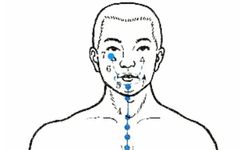What are the Eight Extraordinary Meridians?
The Eight Extraordinary Meridians, referred to as “qi” (奇) meaning unusual, are the eight meridians outside of the twelve primary meridians (正经). They do not directly connect to the organs (脏腑) and have no interior-exterior relationship, hence they are called “extraordinary meridians”.
These include the Ren Mai (任脉, Conception Vessel), Du Mai (督脉, Governing Vessel), Chong Mai (冲脉, Penetrating Vessel), Dai Mai (带脉, Girdle Vessel), Yin Qiao Mai (阴跷脉, Yin Heel Vessel), Yang Qiao Mai (阳跷脉, Yang Heel Vessel), Yin Wei Mai (阴维脉, Yin Linking Vessel), and Yang Wei Mai (阳维脉, Yang Linking Vessel).
Physiological Characteristics of the Eight Extraordinary Meridians
The physiological characteristics of the Eight Extraordinary Meridians can be summarized in three points:
1. The Eight Extraordinary Meridians have no direct connection to the organs.
2. There is no interior-exterior relationship among the Eight Extraordinary Meridians.
3. The distribution of the Eight Extraordinary Meridians is not as widespread as that of the twelve primary meridians; they do not distribute in the upper limbs.
Their pathways also differ from the twelve primary meridians, as all except the Dai Mai ascend from the lower body.
Common Physiological Functions
What are the common physiological functions of the Eight Extraordinary Meridians?
1. They further strengthen the connections between the twelve primary meridians.
For example, the Du Mai governs all Yang meridians; the Ren Mai governs all Yin meridians; the Dai Mai restrains the longitudinal meridians. The two Qiao meridians control the Yin and Yang of the body; the two Wei meridians connect the interior and exterior Yin and Yang. Thus, the Eight Extraordinary Meridians enhance the connections among various parts of the body.
2. They regulate the Qi and blood of the twelve primary meridians.
When the Qi of the twelve primary meridians is excessive, it is stored in the Eight Extraordinary Meridians; when there is a deficiency, the Eight Extraordinary Meridians can “overflow” to provide timely supplementation.
3. The Eight Extraordinary Meridians have a close relationship with the liver, kidneys, and other organs, as well as with the uterus, brain, and marrow, indicating a physiological and pathological connection among them.
Pathways of the Eight Extraordinary Meridians
Ren Mai (任脉)
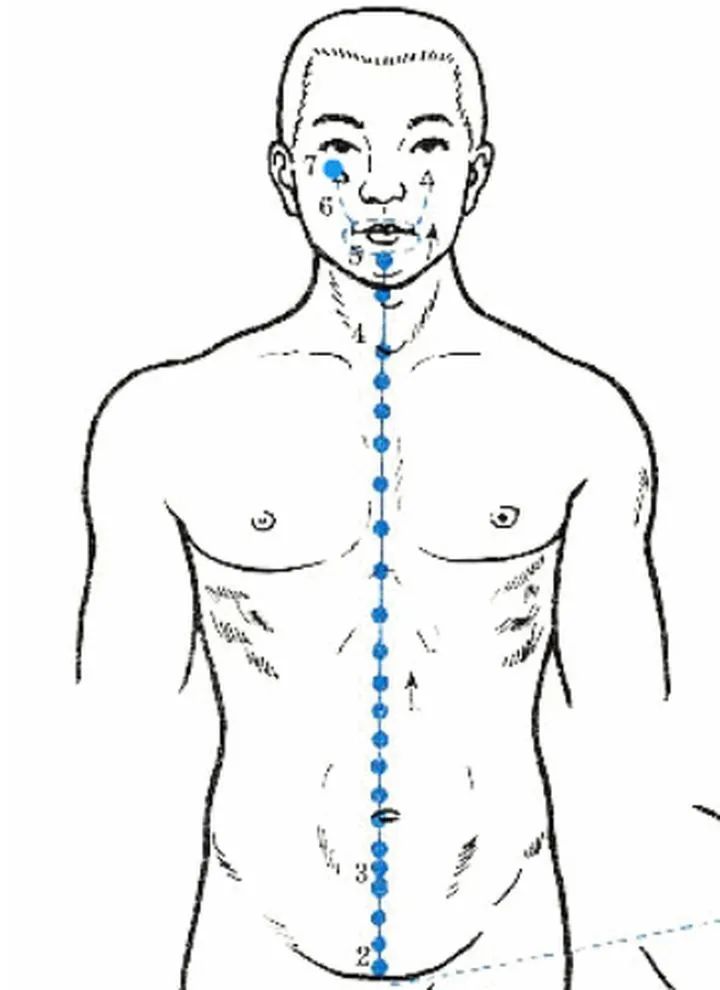
1. Pathway
The Ren Mai originates in the lower abdomen, exits at the perineum, ascends along the midline of the abdomen, passes through the throat (Tian Tu point), reaches the lower lip, divides to encircle the lips, and meets the Du Mai at the Gingival Intersection point, then ascends to the lower eye socket (Cheng Qi point), connecting with the Yangming meridian.
2. Branches
It runs from the lower abdomen through the spine, ascending along the back.
- Physiological Functions
(1) Regulates the Qi and blood of the Yin meridians, as the Ren Mai is known as the “sea of Yin meridians”. It runs along the midline of the abdomen, which is Yin, indicating its role in overseeing and managing the Qi of all Yin meridians. Additionally, the three Yin meridians of the foot intersect with the Ren Mai, allowing it to regulate the Qi and blood of the Yin meridians, hence the saying “governs all Yin”.
(2) Regulates menstruation and supports fetal development. The Ren Mai originates in the lower abdomen, playing a role in regulating menstruation and promoting female reproductive functions, hence the saying “Ren governs the uterus”.
Du Mai (督脉)
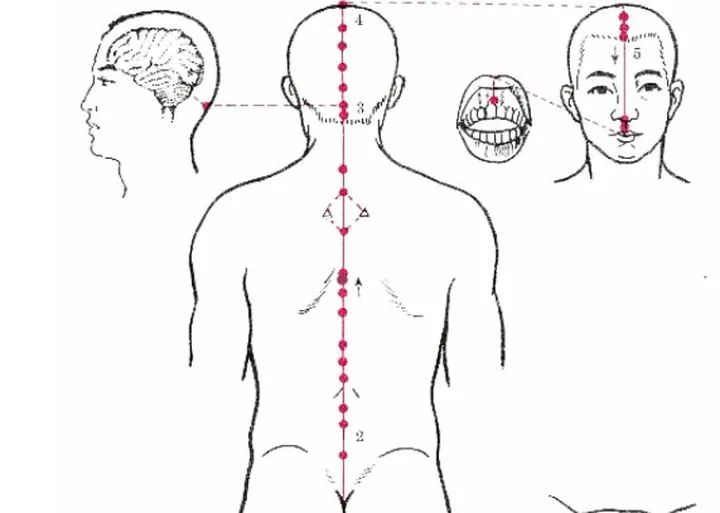
1. Pathway
The Du Mai originates in the lower abdomen, exits at the perineum, travels to the tailbone (Chang Qiang point), ascends along the spine, passes through the neck to the Feng Fu point, enters the brain, and runs along the midline of the head, reaching the Bai Hui point at the top of the head, then descends through the forehead to the tip of the nose (Su Liao point), passing through the philtrum to the Gingival Intersection point.
2. Branches
The first branch, along with the Chong and Ren meridians, originates in the lower abdomen, exits at the perineum, and meets the Kidney and Bladder meridians at the tailbone, connecting to the spine. The second branch ascends from the lower abdomen through the navel, reaching the throat, where it meets the Chong and Ren meridians, then descends to the jaw, encircling the lips, and reaching the center below the eyes. The third branch, originating from the inner corner of the eye, ascends to the forehead, meeting at the top of the head, connecting to the brain, then descends along the back of the neck, along the muscles beside the spine, reaching the waist, and connecting to the kidneys.
3. Physiological Functions
(1) Regulates the Qi and blood of the Yang meridians, as the Du Mai is known as the “sea of Yang meridians”. It runs along the back, which is Yang, indicating its role in overseeing and managing the Qi of all Yang meridians. Additionally, all six Yang meridians meet at the Da Zhui point, showing the Du Mai’s regulatory role over the Yang meridians, hence the saying “governs all Yang meridians”.
(2) Reflects the functions of the brain, kidneys, and spinal cord. The Du Mai is associated with the brain and connects to the kidneys. The kidneys produce marrow, and the brain is considered the sea of marrow.
(3) Governs reproductive functions. The Du Mai connects to the kidneys, which govern reproduction, thus linking the Du Mai to reproductive functions.
Chong Mai (冲脉)
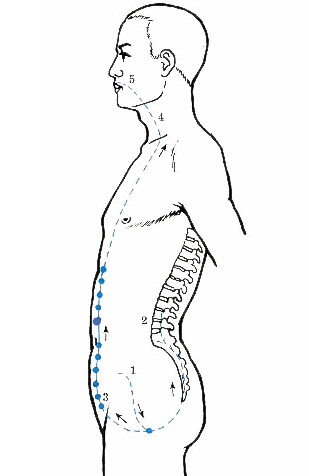
1. Pathway
The Chong Mai originates in the uterus, exits at the perineum, and divides into two branches. The ascending branch (the main part of the Chong Mai) runs along the anterior abdominal wall, near the navel, ascends, connects with the Kidney meridian, spreads in the chest, then ascends through the throat, encircling the lips; the descending branch runs along the posterior abdominal wall, ascending along the spine.
2. Physiological Functions
(1) Regulates the Qi and blood of the twelve primary meridians. The Chong Mai runs from the head to the feet, connecting the entire body, serving as a crucial point for the Qi and blood of all meridians. When the Qi and blood of the meridians are excessive, the Chong Mai can store and reserve it; when there is a deficiency, it can provide infusion and supplementation to maintain the normal physiological activities of the body’s organs and tissues, hence it is known as the “sea of the twelve meridians”, “sea of the five organs and six bowels”, and “sea of blood”.
(2) Governs reproductive functions. The Chong Mai originates in the uterus, also known as the “blood chamber” or “sea of blood”. It plays a role in regulating menstruation and is closely related to reproductive functions. For women, “when the Chong Mai is abundant, menstruation occurs regularly, leading to fertility”; conversely, “when the Chong Mai is deficient, menstruation is irregular, leading to infertility”.
(3) Regulates the ascending and descending of Qi. The Chong Mai connects with the Kidney meridian, belongs to the Yangming, and connects to the Jueyin and Taiyang. It has the function of regulating the ascending and descending of Qi in certain organs (mainly the liver, kidneys, and stomach).
Dai Mai (带脉)
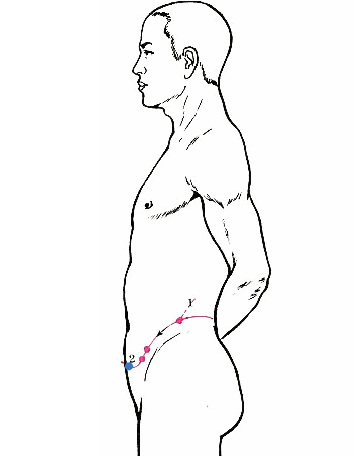
1. Pathway
The Dai Mai originates at the lateral costal region, descending obliquely, meeting the Gallbladder meridian at the Dai Mai point, encircling the body and then descending along the upper edge of the hip bone to the lower abdomen.
2. Physiological Functions
It restrains the longitudinal meridians and governs women’s leukorrhea.
Yin Qiao Mai (阴跷脉)
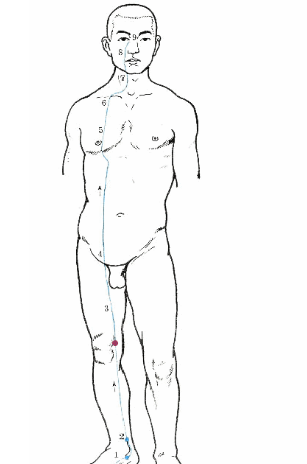
1. Pathway
The Yin Qiao Mai originates at the inner side of the heel from the Kidney meridian (Zhao Hai point), ascends through the inner ankle, along the inner thigh to the anterior genital area, then ascends along the abdominal front to the chest, reaching the Xue Pen point, and ascends beside the Adam’s apple to the nasal area, connecting with the inner corner of the eye, meeting the Taiyang and Yang Qiao meridians.
2. Physiological Functions
It controls the opening and closing of the eyes and the movement of the muscles.
Yang Qiao Mai (阳跷脉)
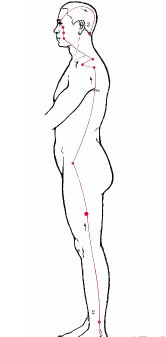
1. Pathway
The Yang Qiao Mai originates at the outer side of the heel from the Bladder meridian (Shen Mai point), ascends along the outer ankle, along the outer edge of the lower limb to the abdomen, along the posterior outer side of the chest, through the shoulder, and ascends to the corner of the mouth, reaching the inner corner of the eye. It connects with the Bladder and Yin Qiao meridians, then ascends along the Bladder meridian to meet the Shaoyang meridian at the Feng Chi point.
2. Physiological Functions
It controls the opening and closing of the eyes and the movement of the muscles.
Yin Wei Mai (阴维脉)
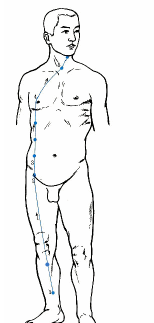
1. Pathway
The Yin Wei Mai originates five cun above the inner ankle from the Kidney meridian (Zhu Bin point), ascends along the inner edge of the lower limb to the abdomen, travels with the Spleen meridian to the lateral costal region, connects with the Liver meridian, then ascends to meet the Tian Tu point of the Ren Mai, and terminates at the Lian Quan point in the throat.
2. Physiological Functions
The term “Wei” in Yin Wei means to connect and link. The Yin Wei has the function of linking the Yin meridians.
Yang Wei Mai (阳维脉)
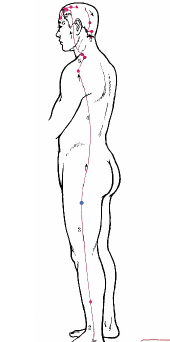
1. Pathway
The Yang Wei Mai originates from the Jin Men point of the Bladder meridian, passes over the outer ankle, ascends along the outer edge of the lower limb, travels along the posterior outer side of the trunk, from the back of the armpit to the shoulder, ascends through the neck, behind the ear, and moves forward to the forehead, distributing over the side of the head and back of the neck, connecting with the Du Mai.
2. Physiological Functions
It links the Yang meridians.
【Learn Meridians】 Exciting recommendations, click to explore
| Human Meridian Inquiry | Human Acupoint Inquiry | Common Disease Inquiry |
| Massage Techniques Explained | Technique Video Explanation | Pediatric Disease Inquiry |
| Hand Diagnosis | Facial Diagnosis | Nine Body Constitutions |
| Tongue Diagnosis | Back Diagnosis | Foot Reflex Zones |
If you find this useful, please click below to  View
View

